Why you can trust Tom's Hardware
Our standard benchmarks and power tests are performed using the CPU’s stock frequencies (including any default boost/turbo) with all power-saving features enabled. We set optimized defaults in the BIOS and the memory by enabling the XMP profile. For this baseline testing, the Windows power scheme is set to Balanced (default) so the PC idles appropriately.
Synthetic Benchmarks
Synthetics provide a great way to determine how a board runs, as identical settings should produce similar performance results. Turbo boost wattage and advanced memory timings are places where motherboard makers can still optimize for stability or performance, though, and those settings can impact some testing.
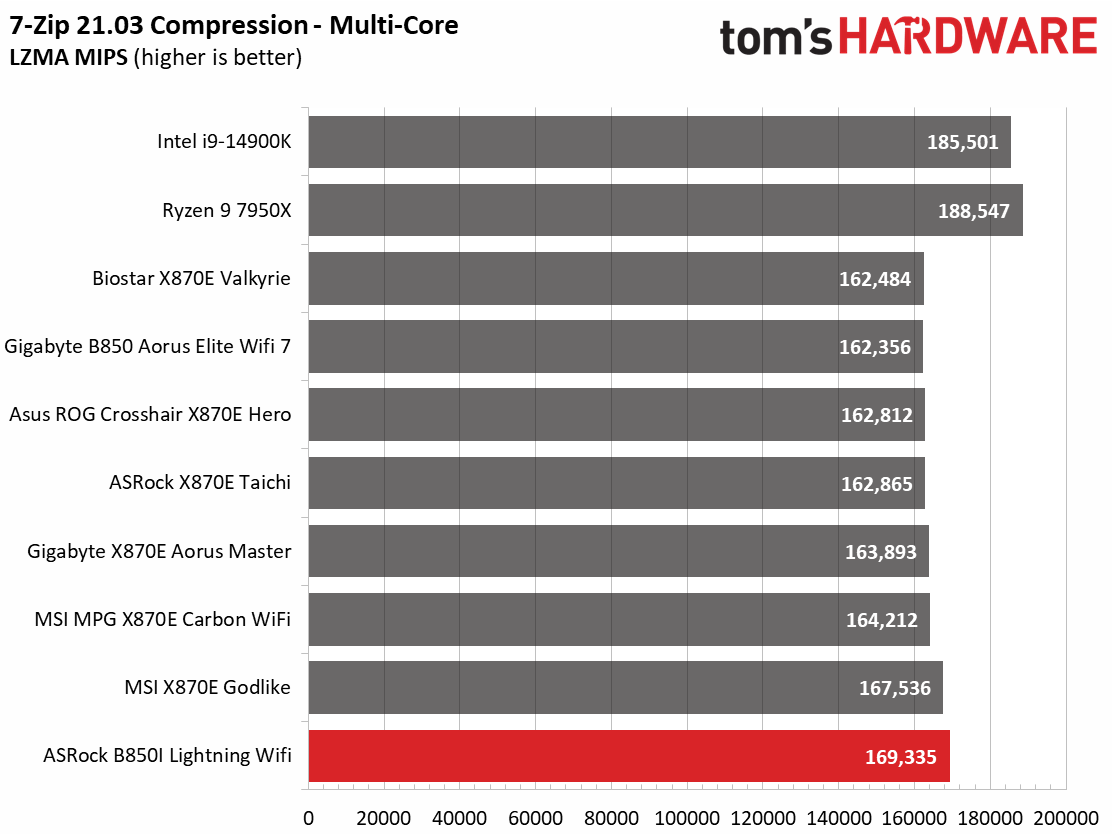
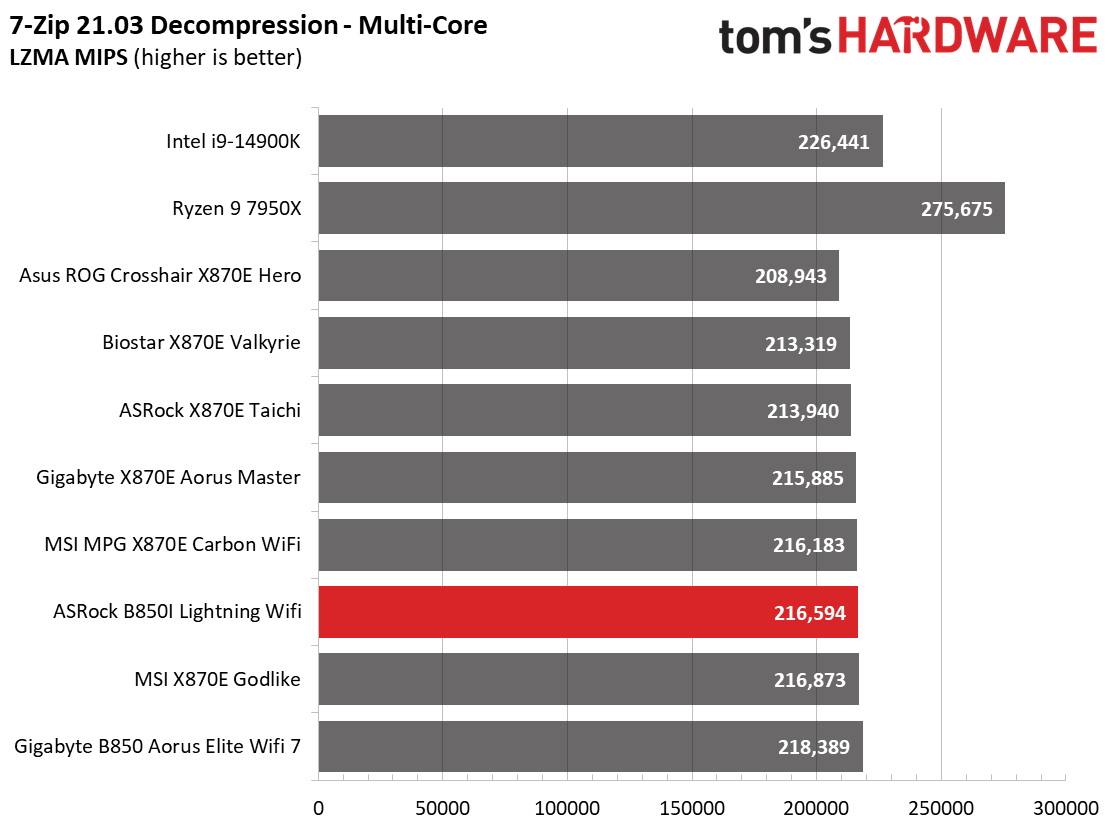
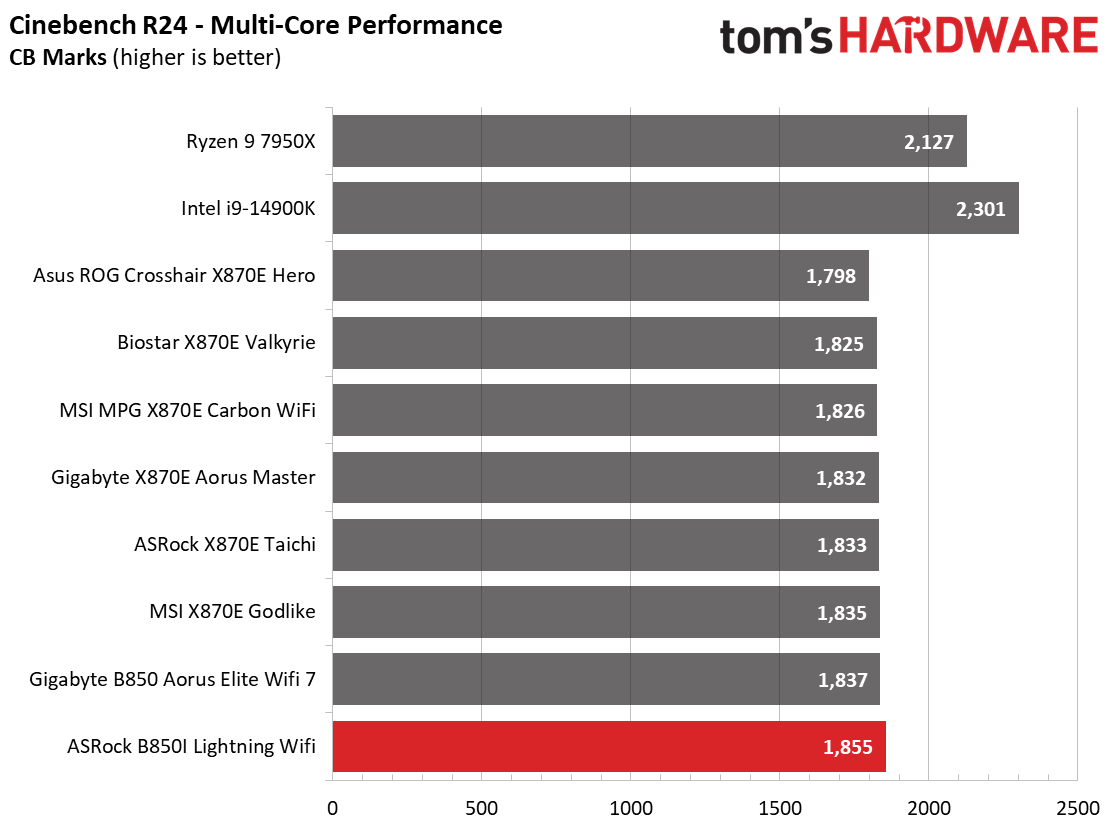
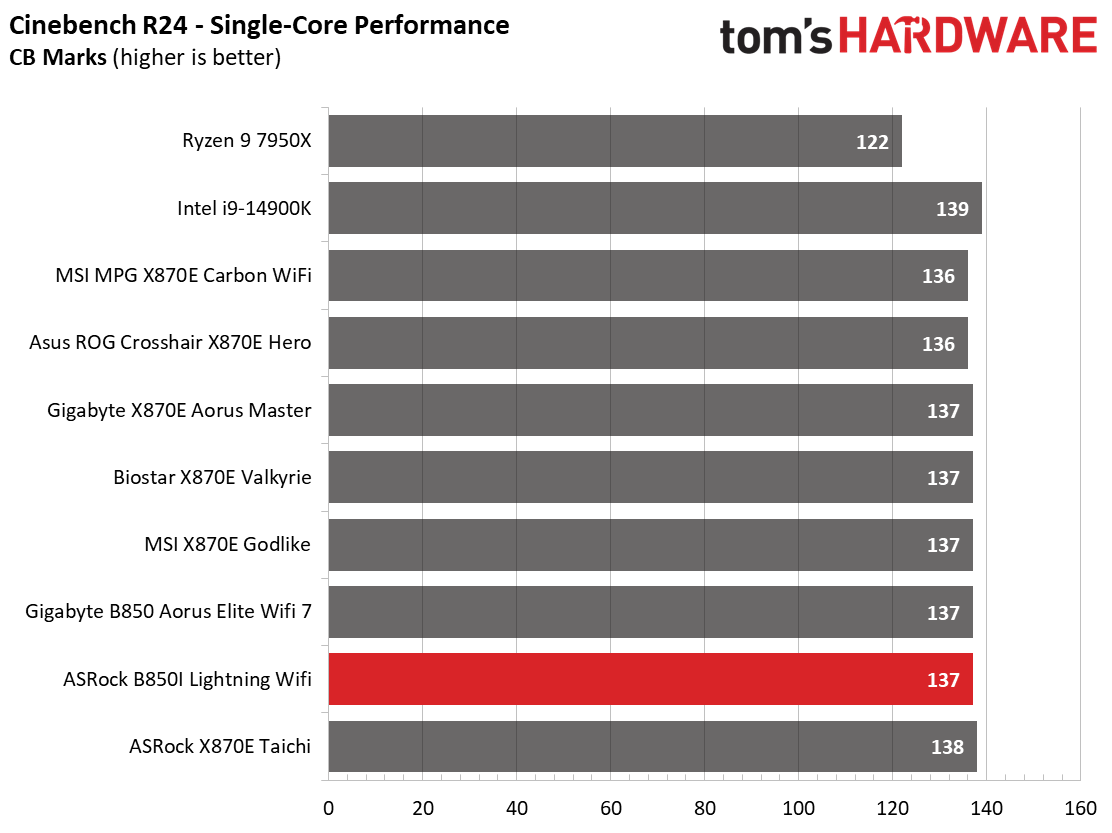

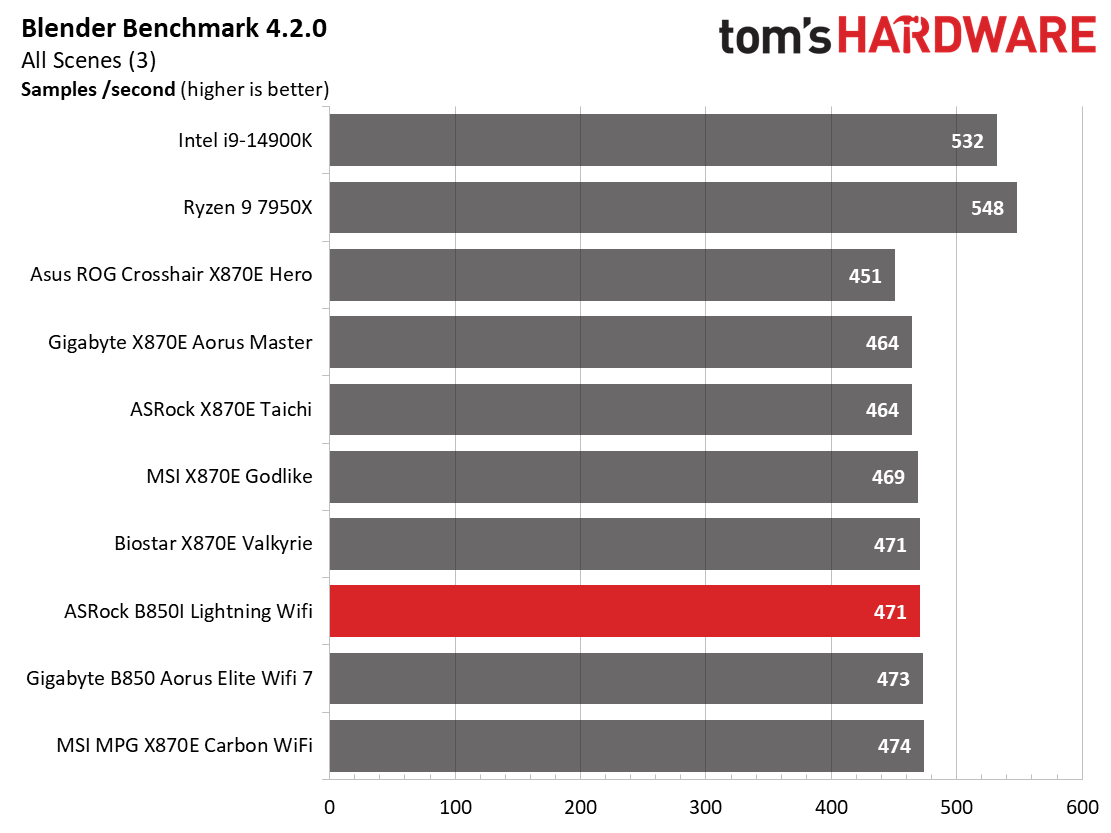
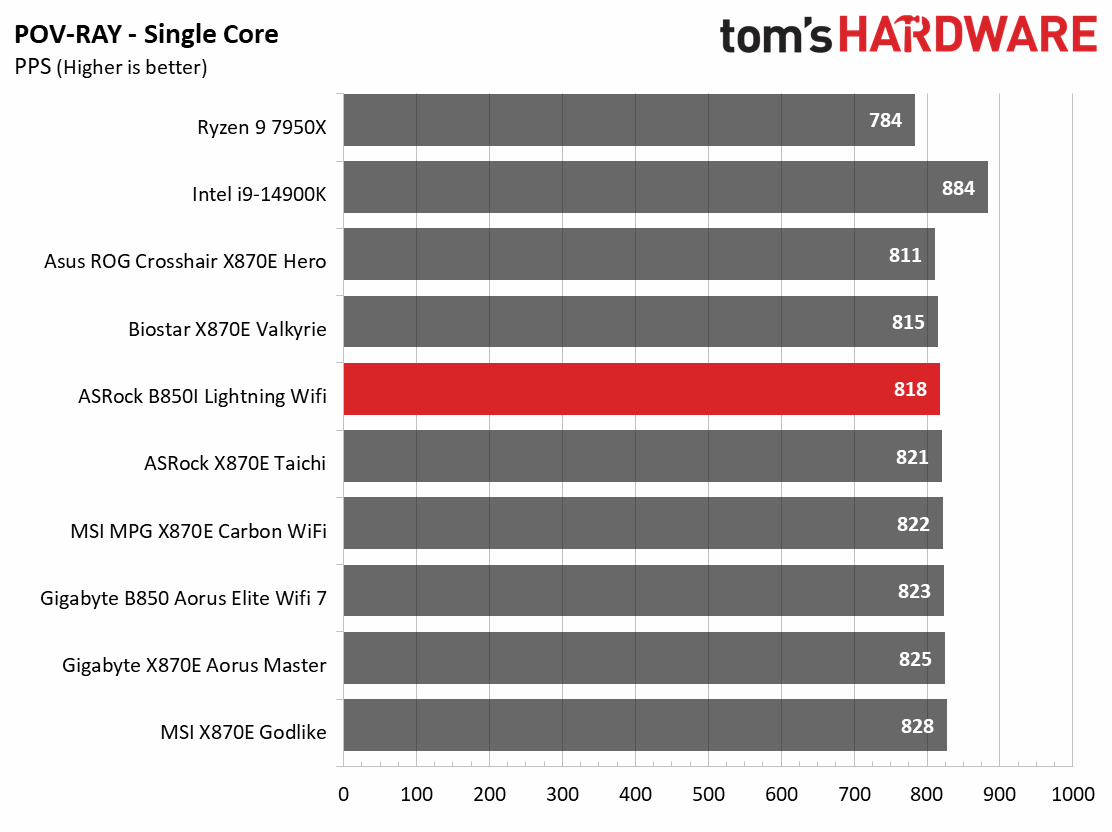
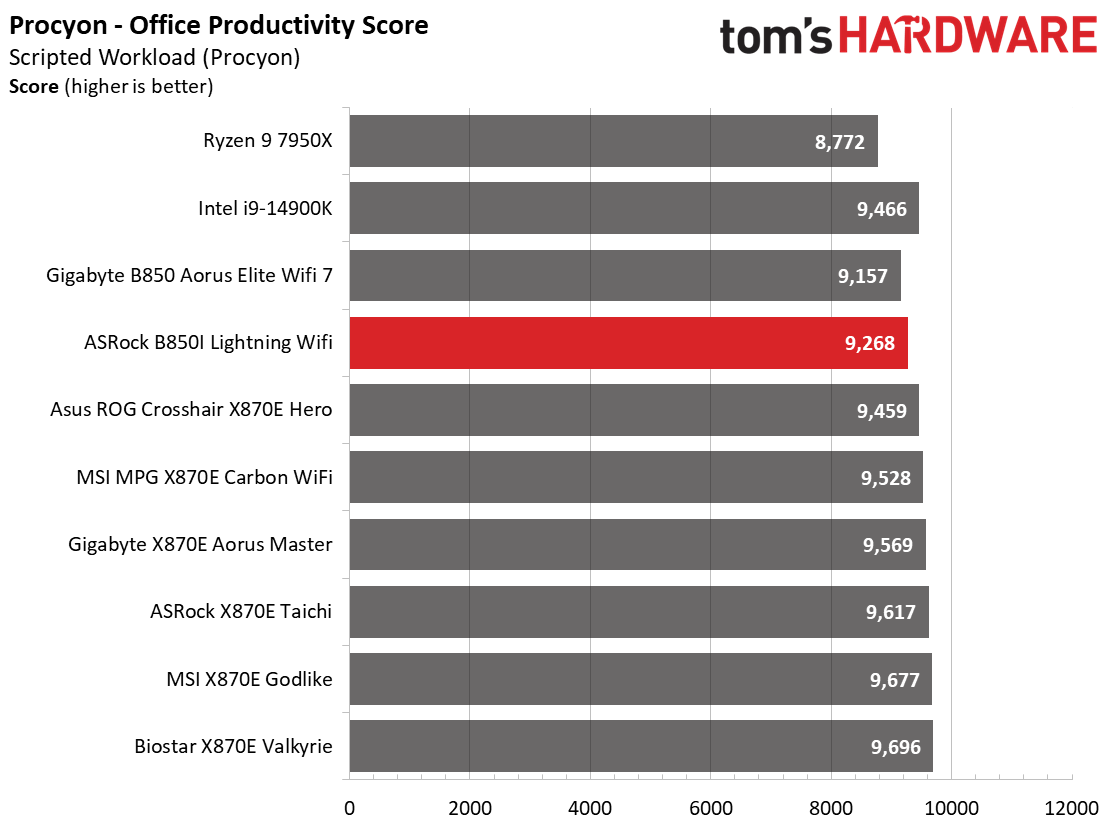
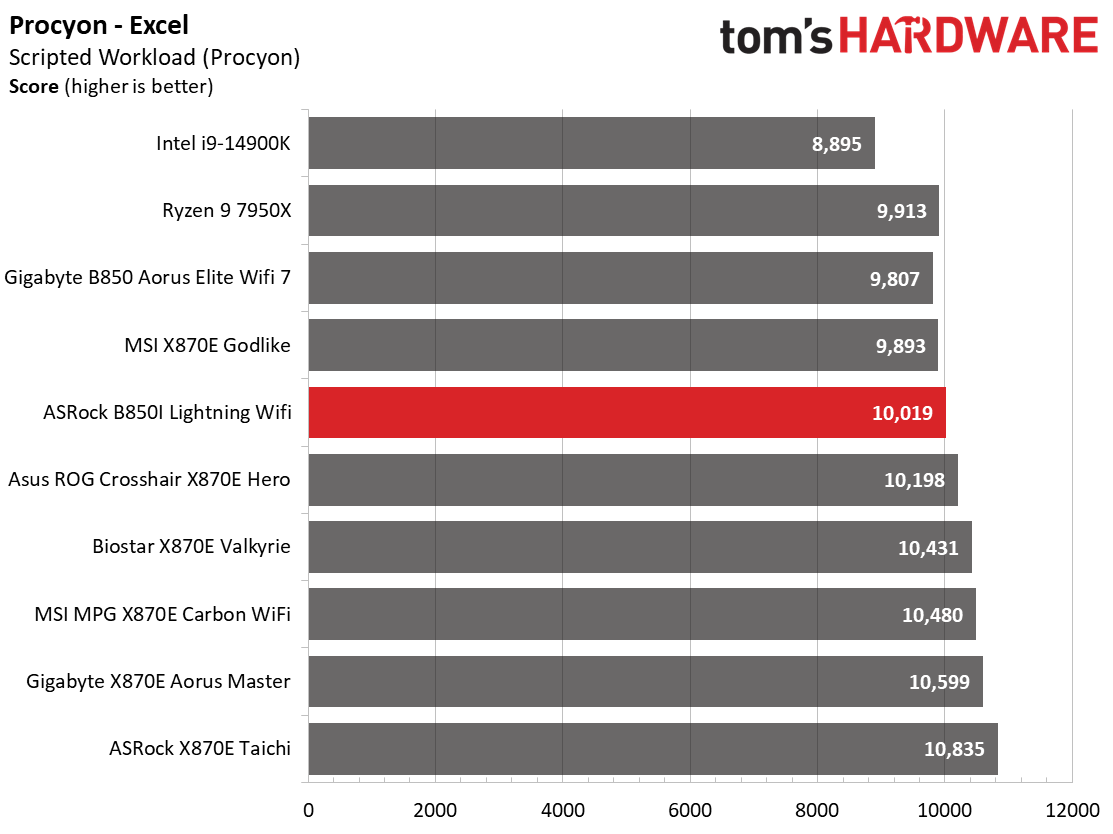
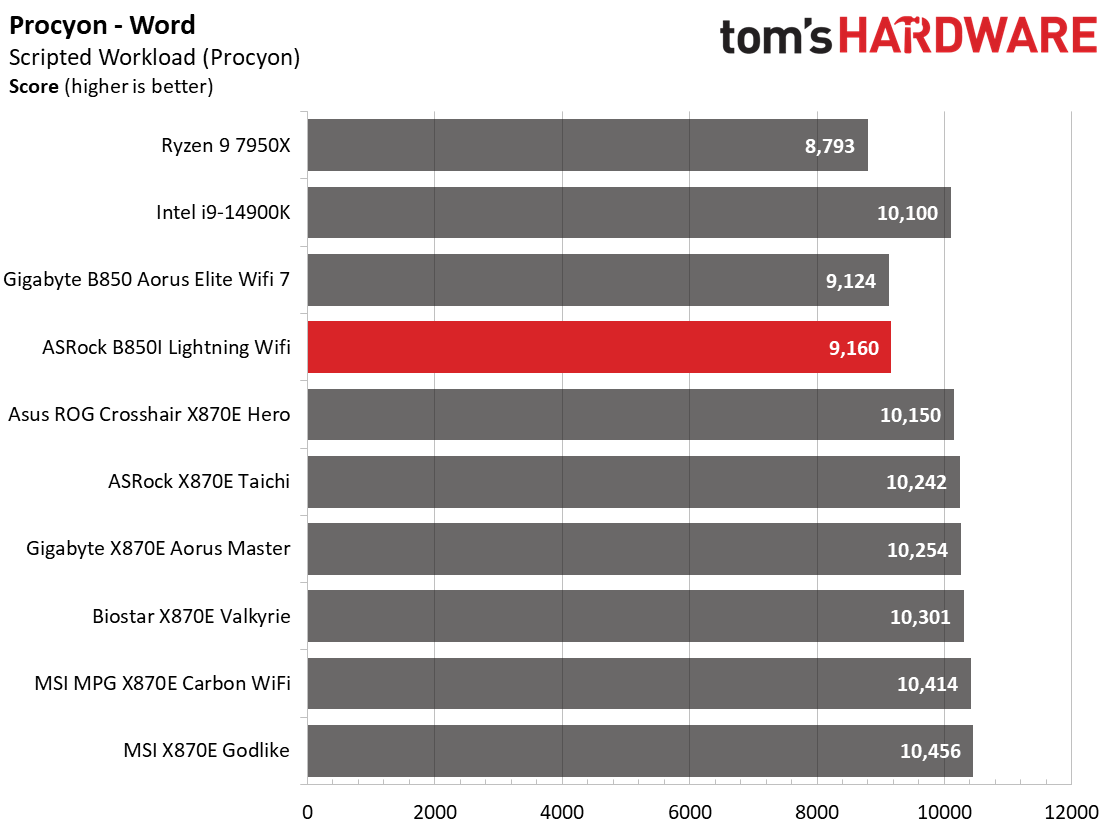
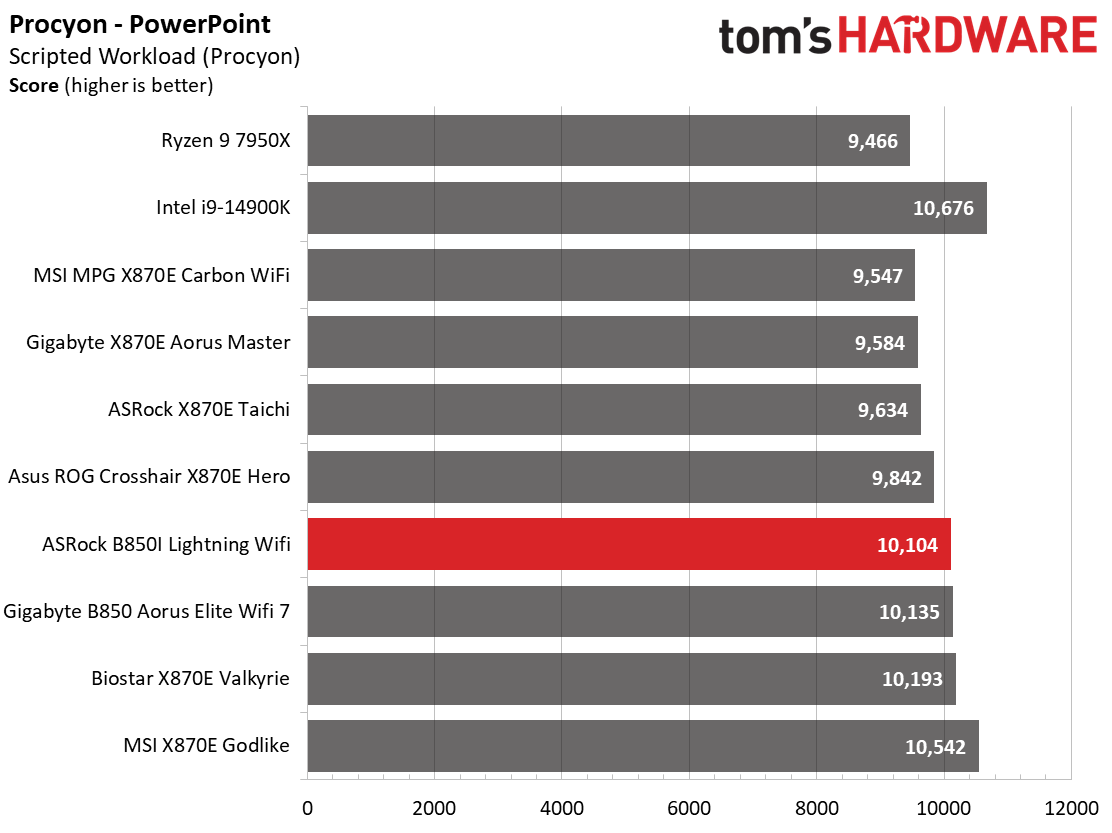
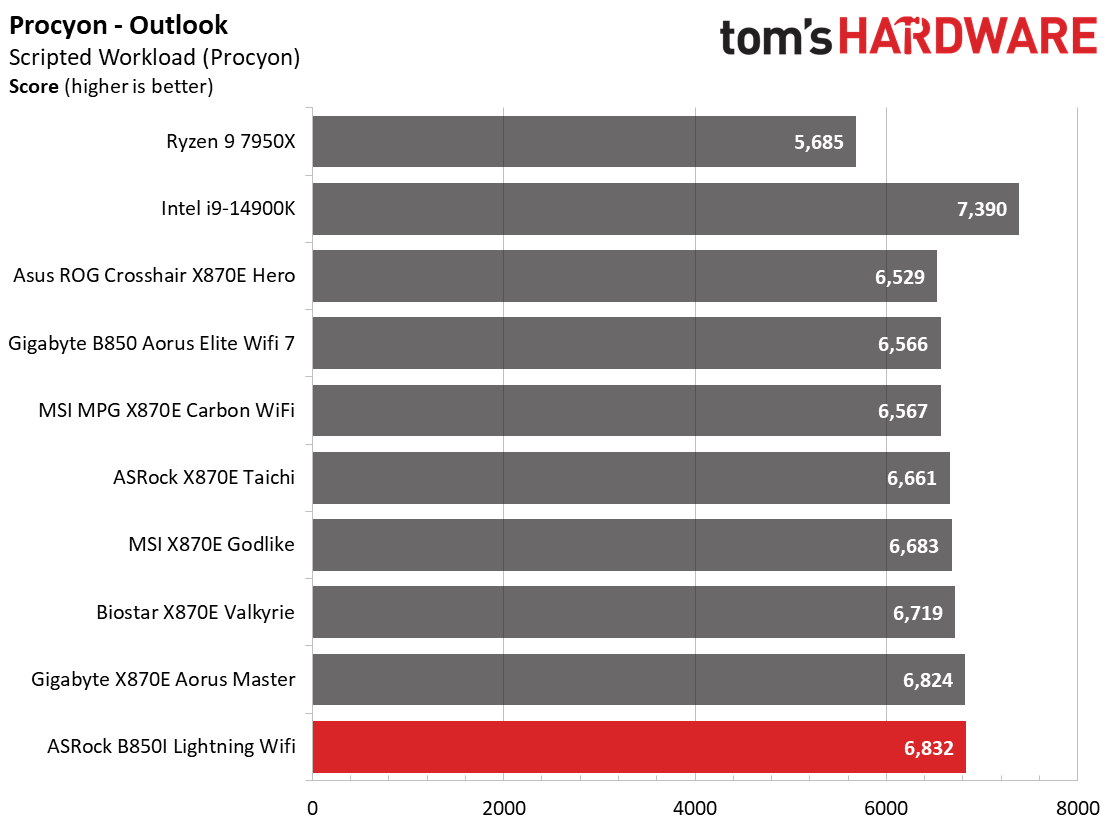
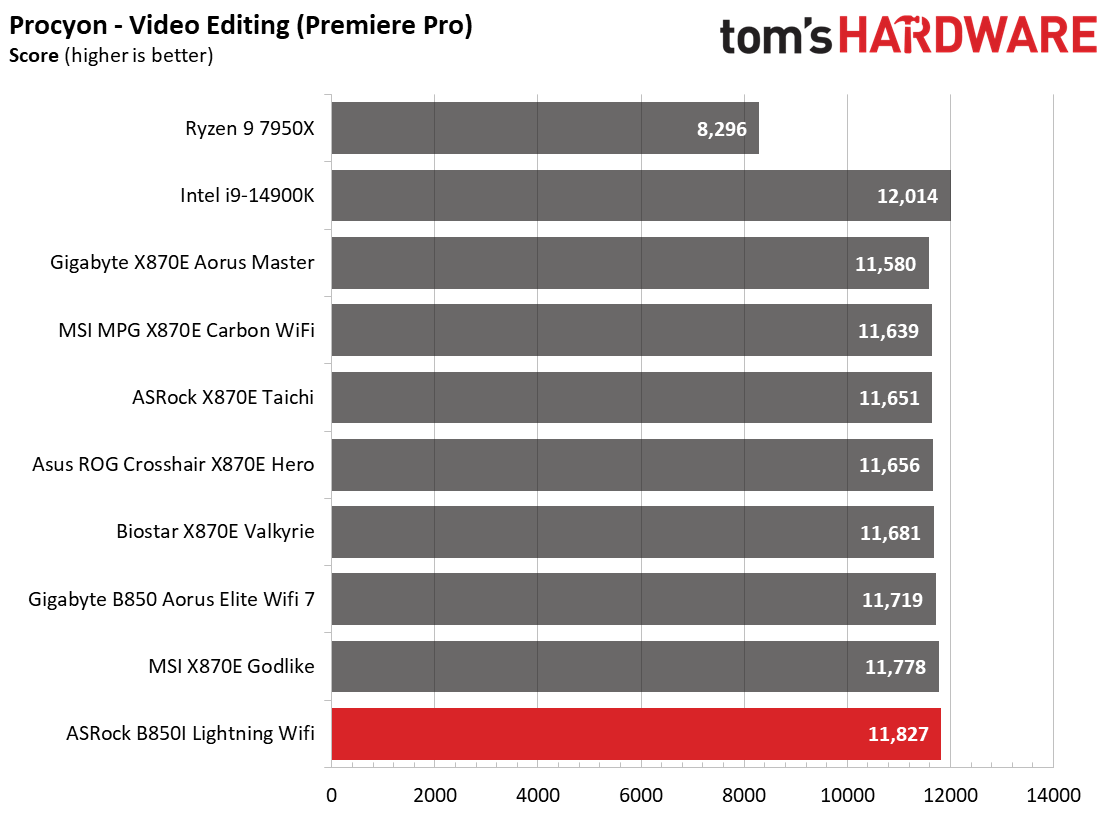
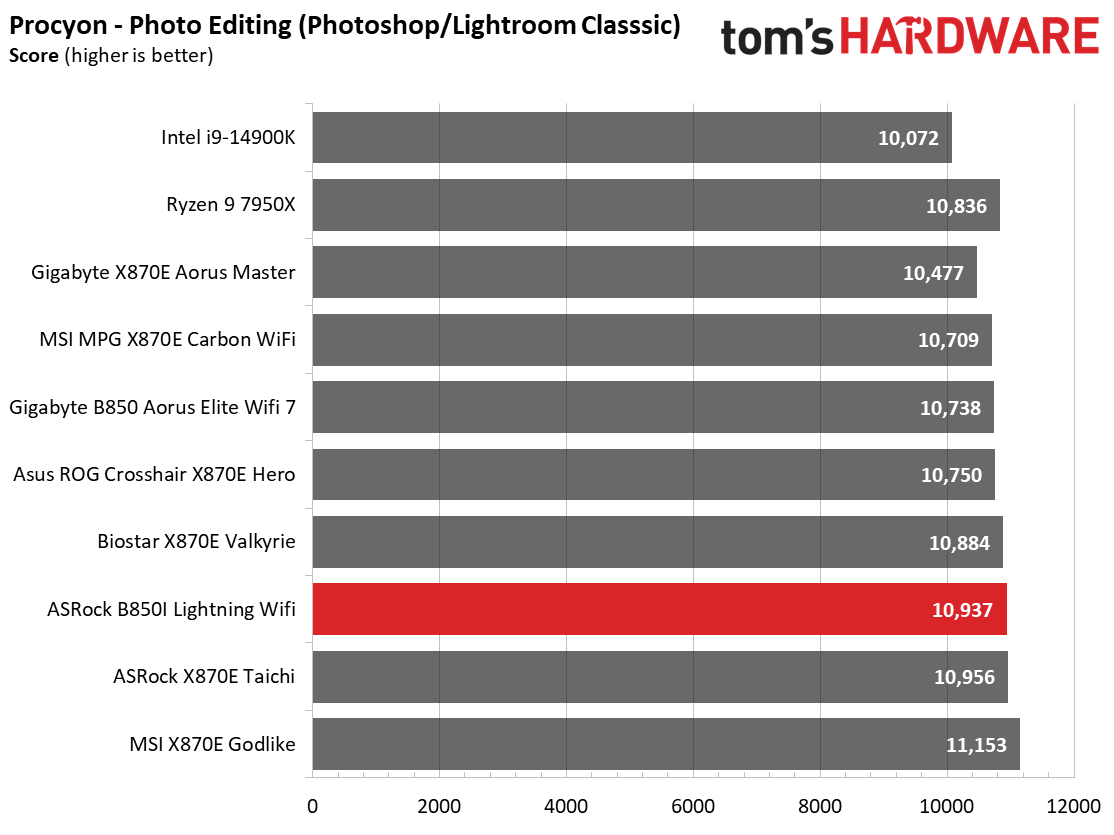
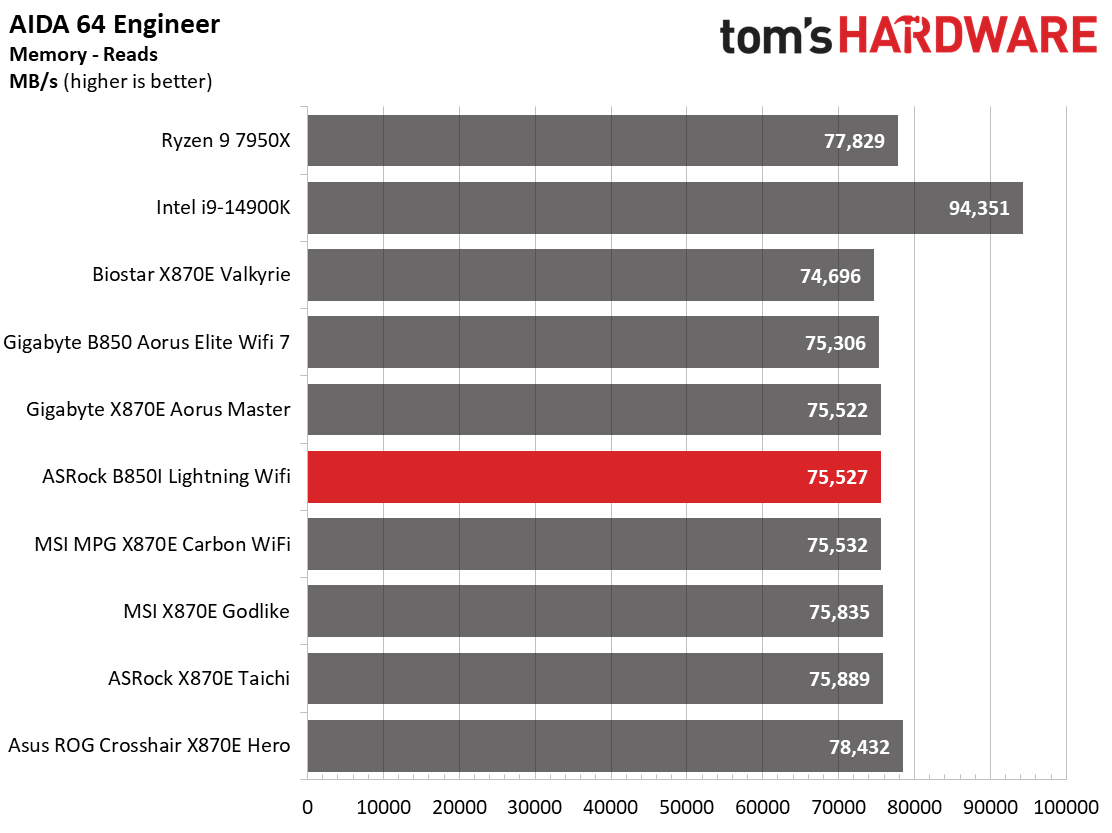
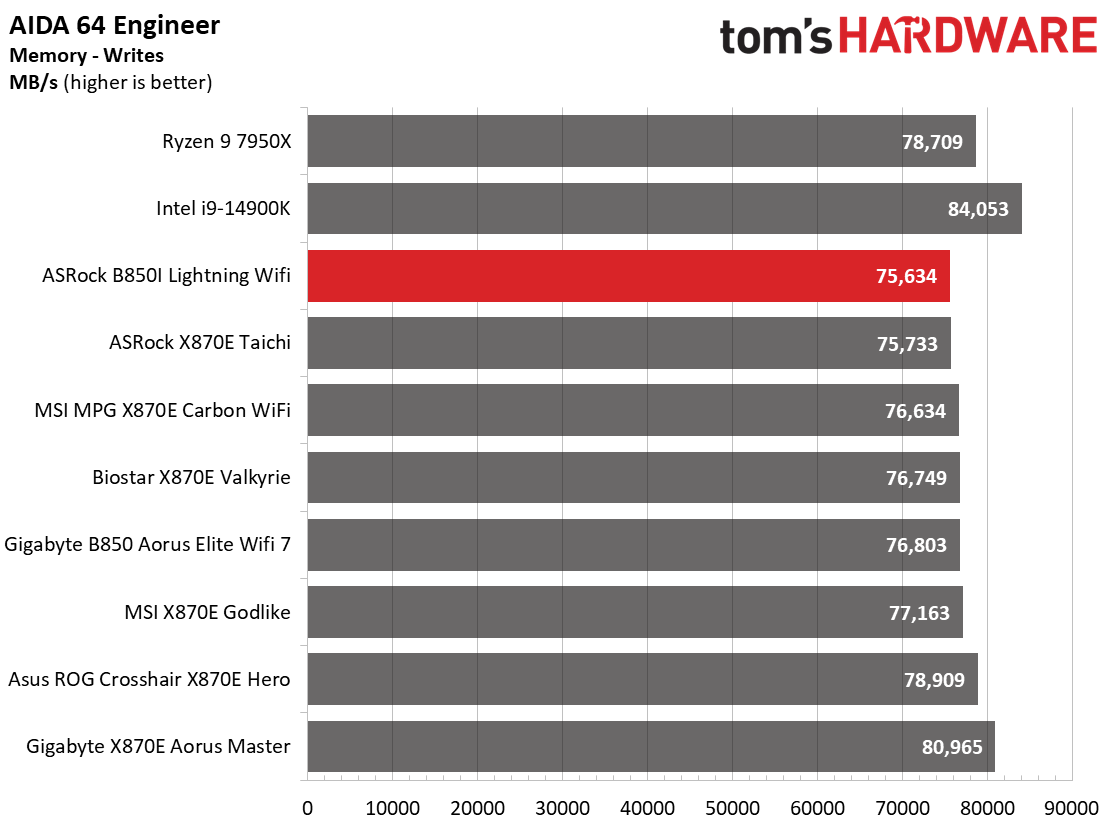
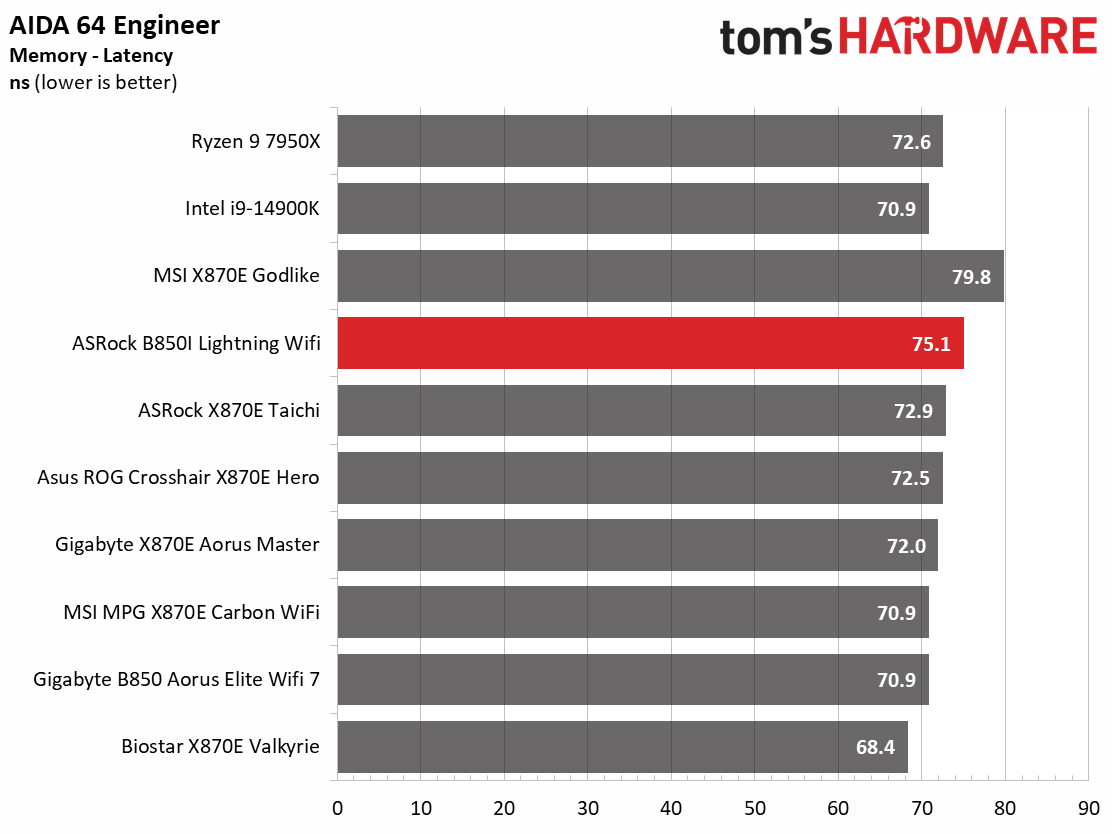
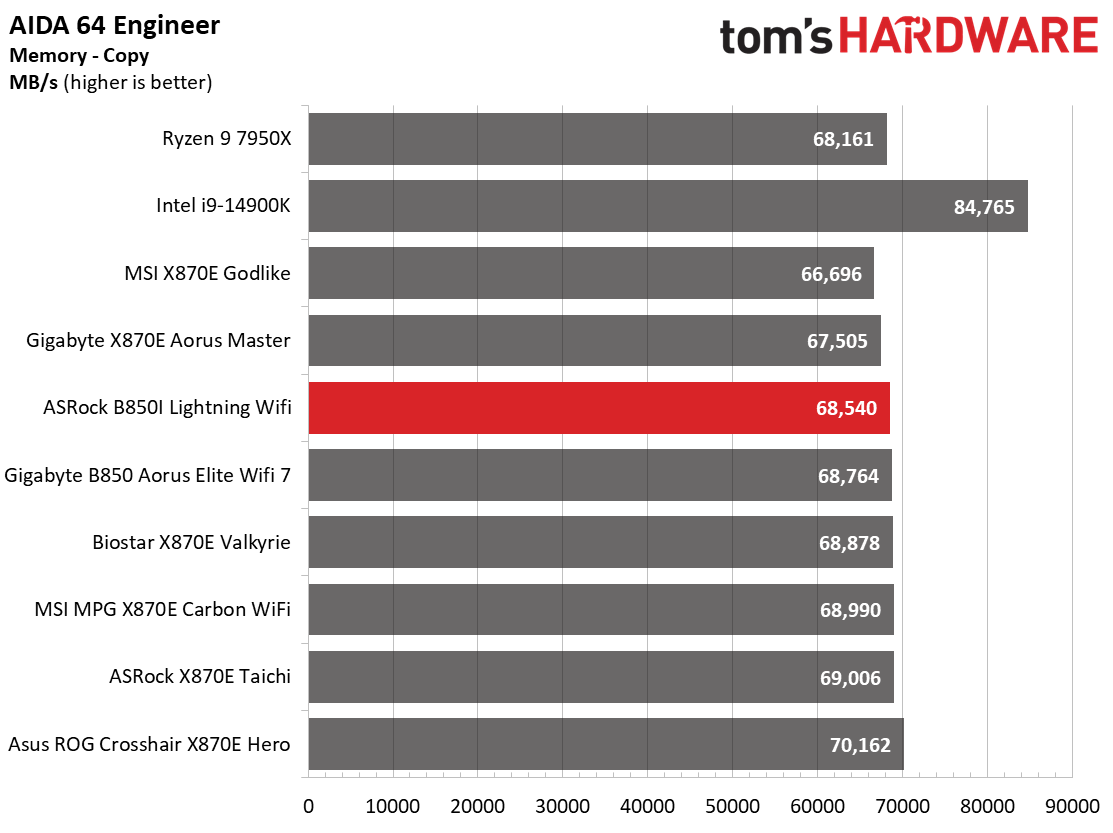
The board did well across our synthetic applications, with average to above-average results in all these tests. There is nothing abnormal to report.
Timed Applications
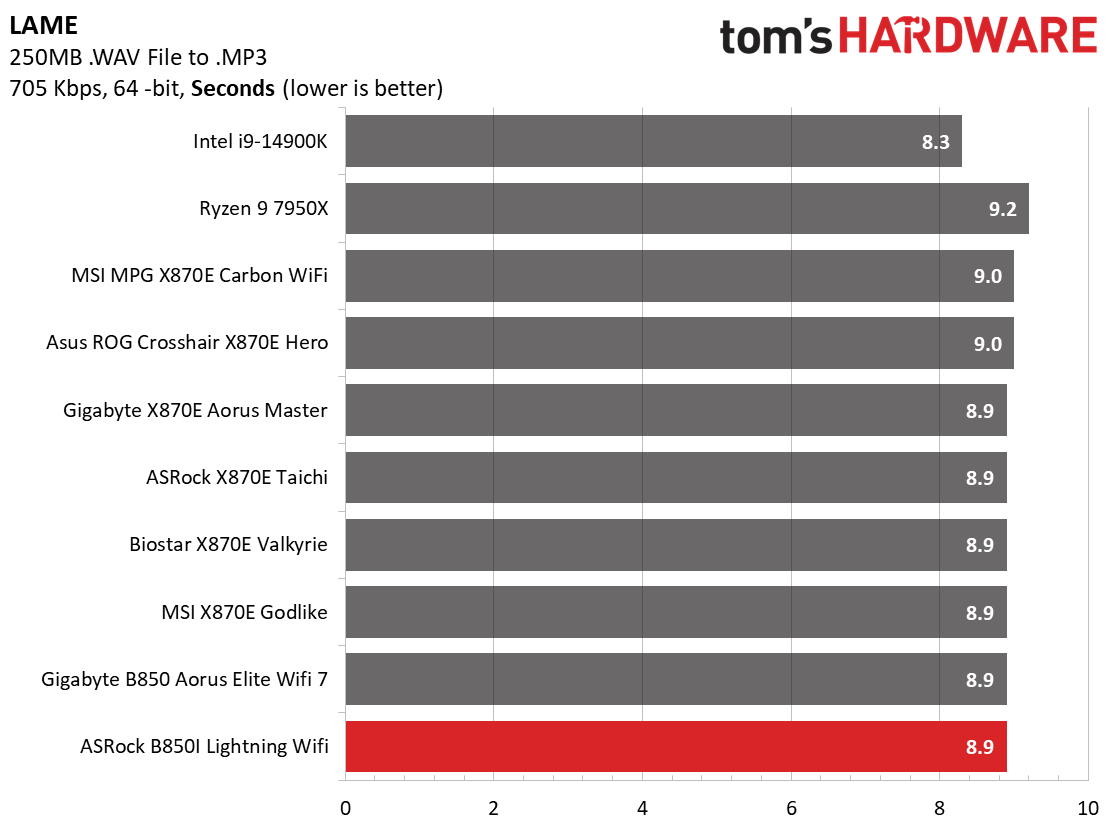
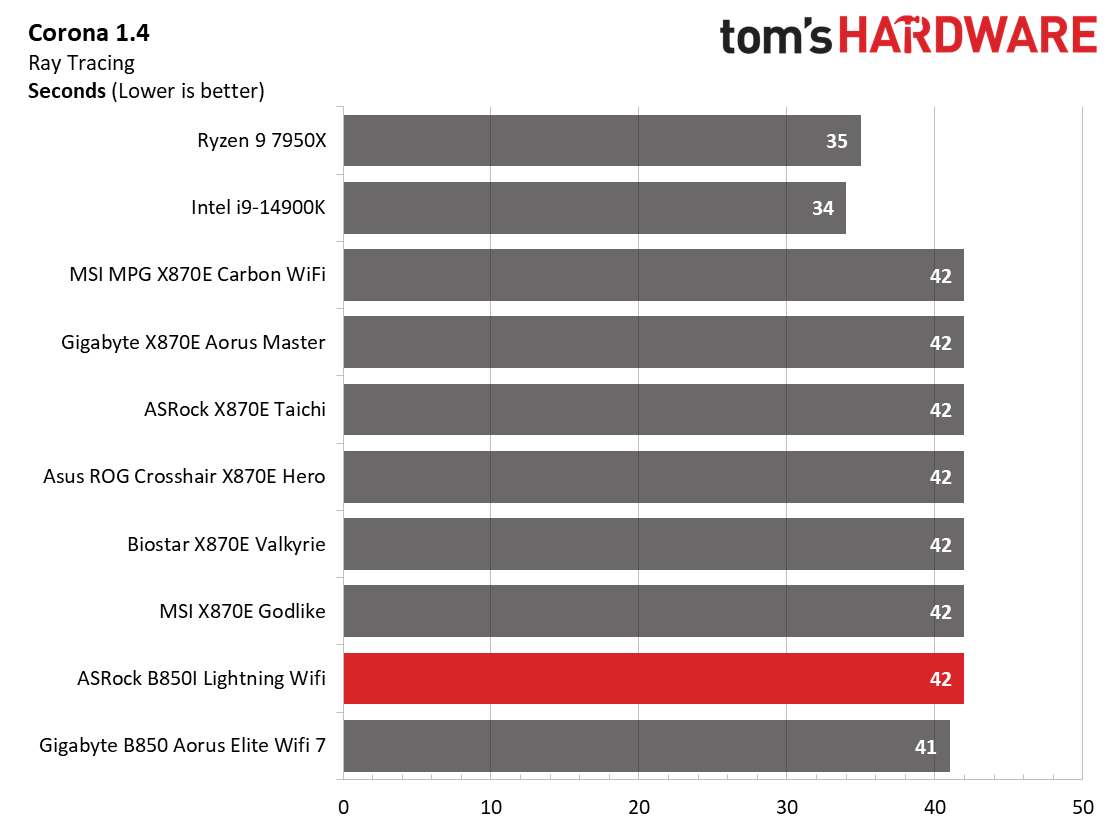
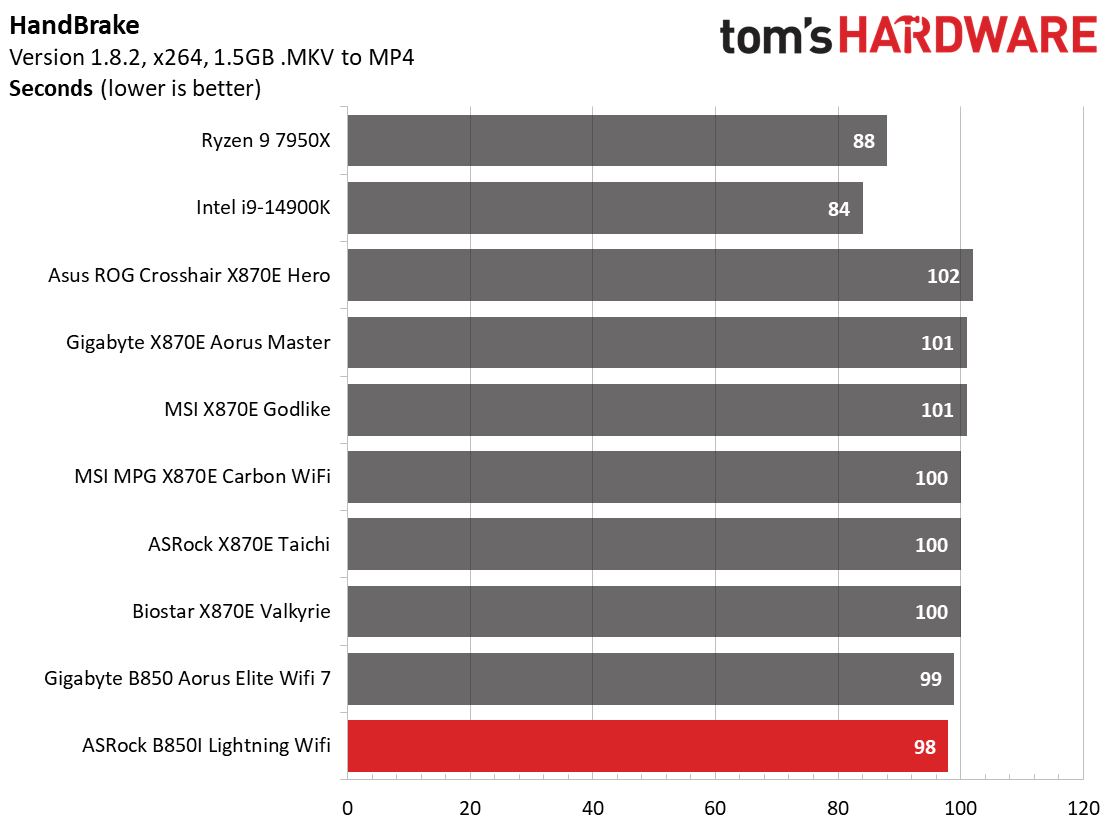
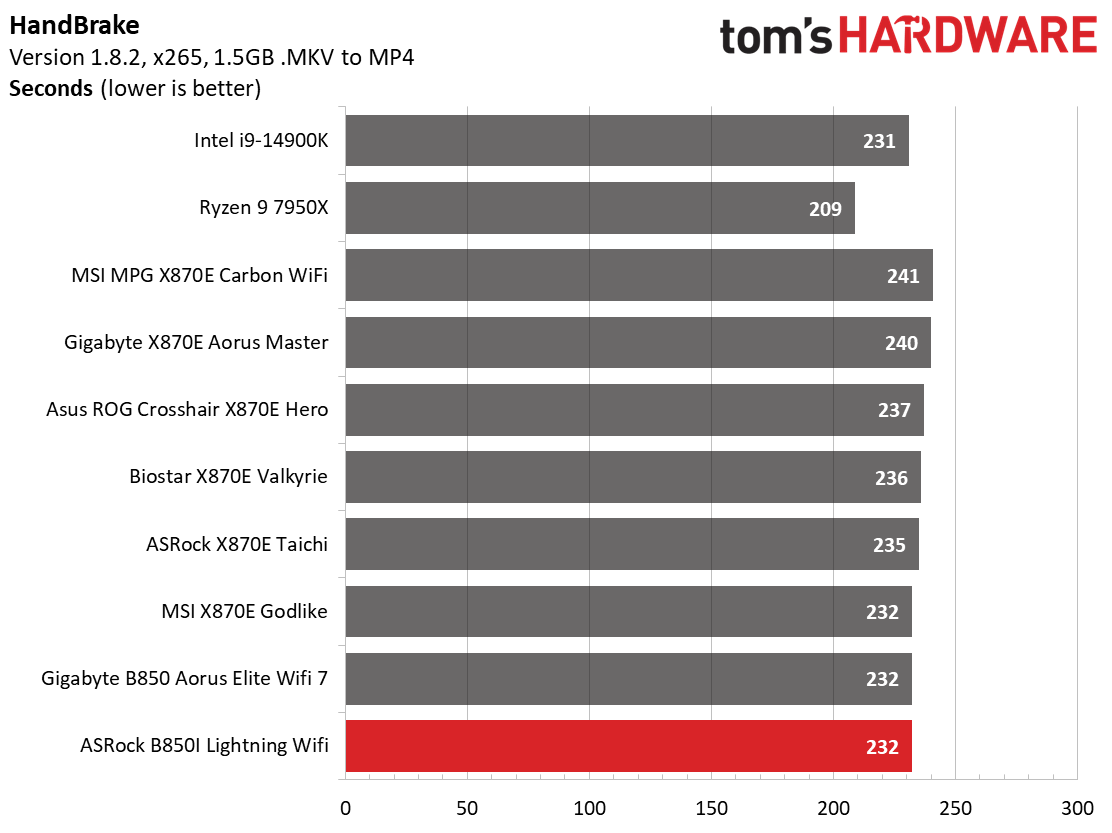
While the results in the timed benchmarks are all tightly packed, the B850I Lightning WiFi continued to do well and lead most other results. It was first in LAME, and both Handbrake tests were mixed in with the other boards in Corona—another good showing.
3D Games and 3DMark
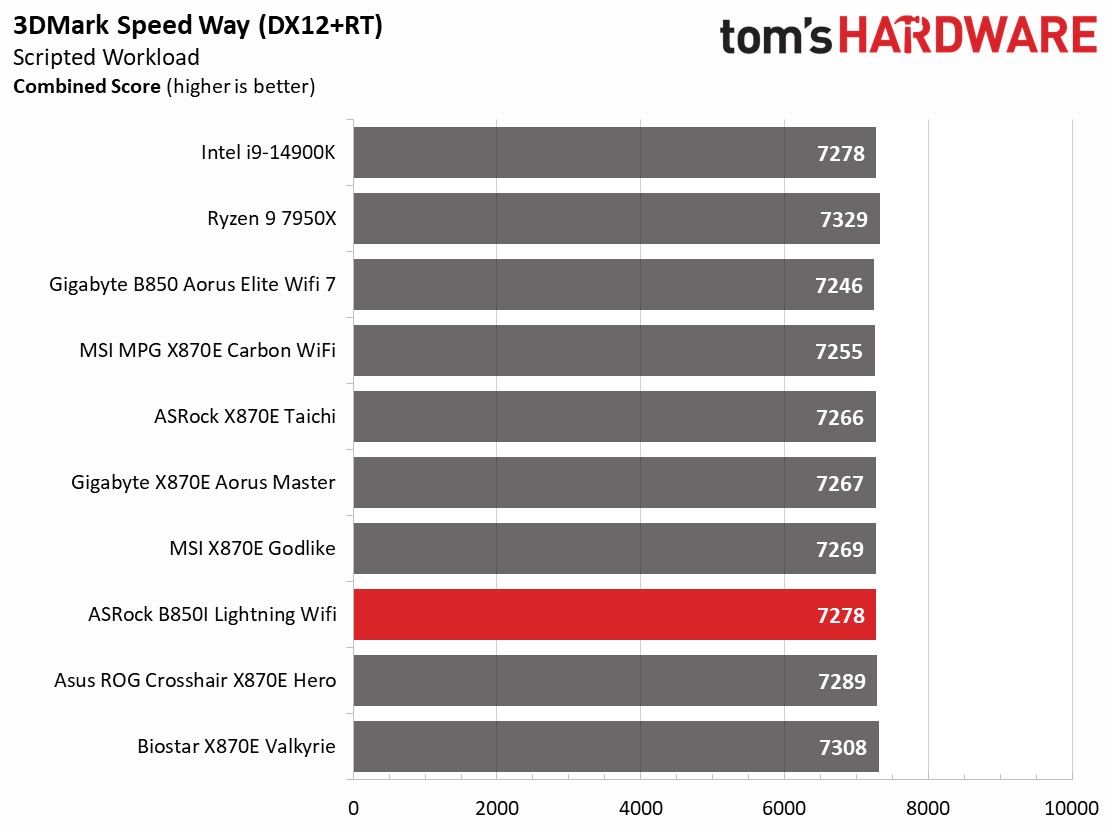
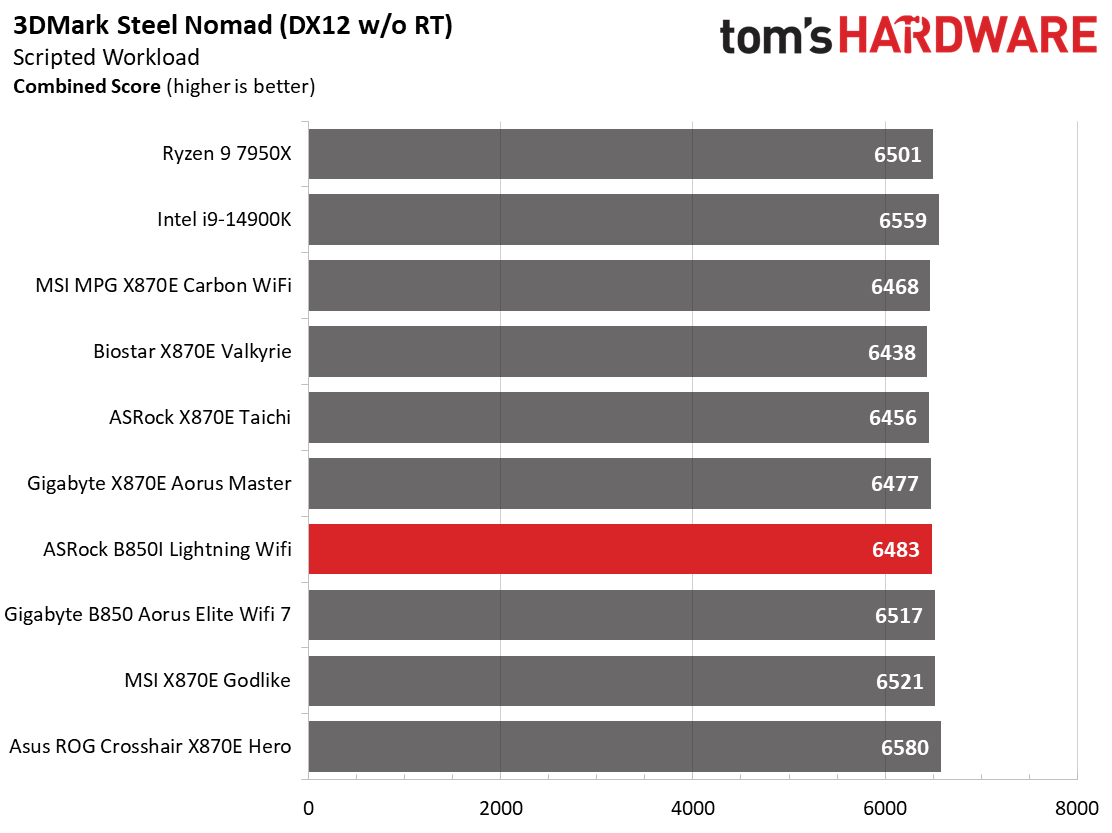
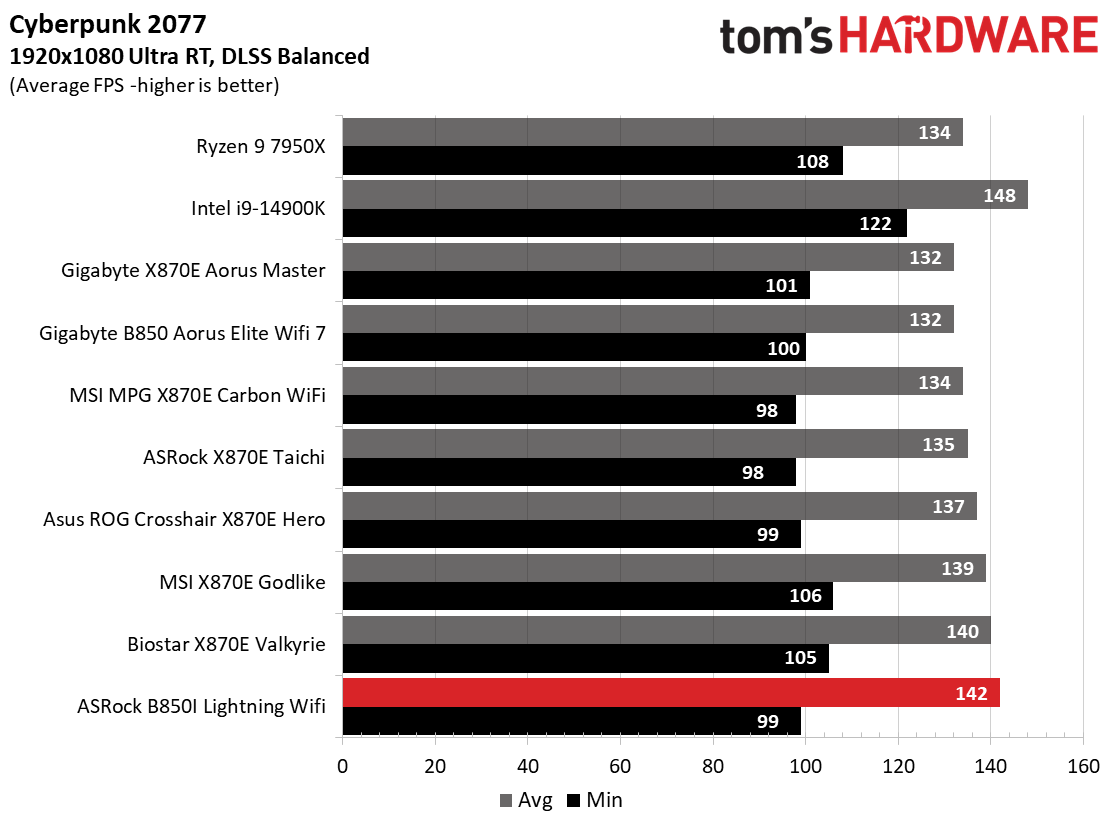
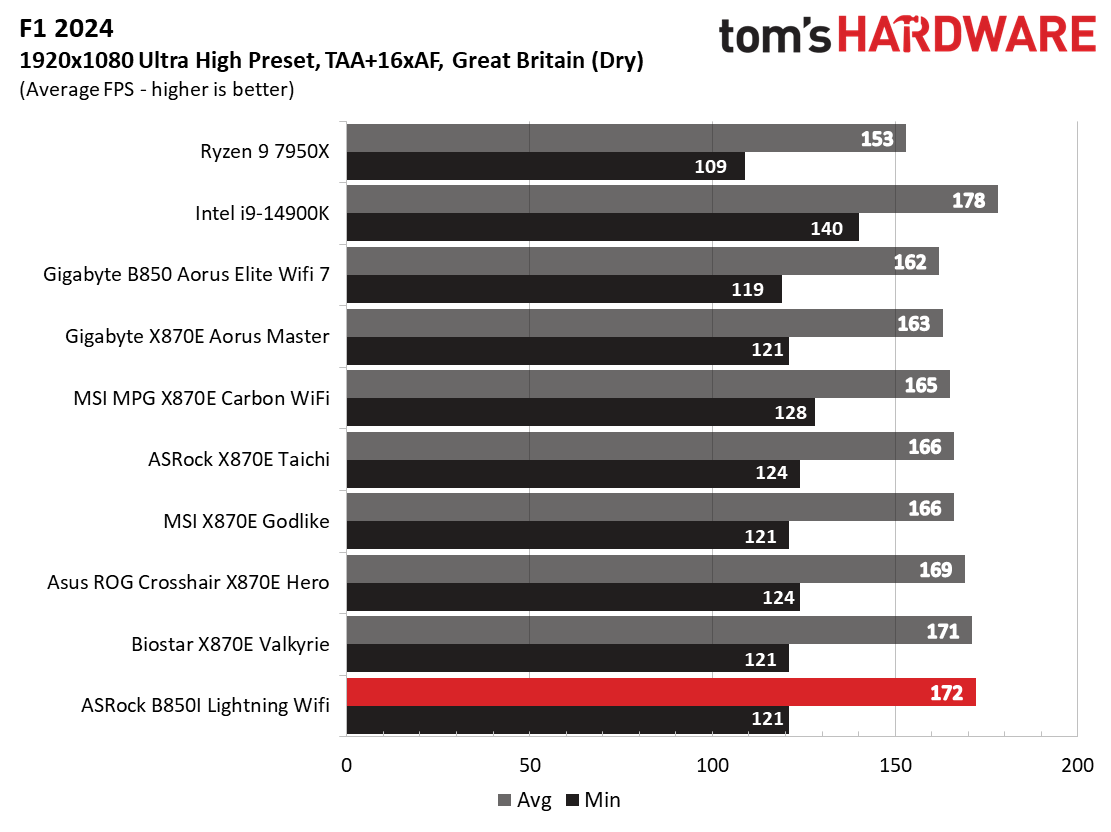
Starting with the launch of Zen 5, we’ve updated our game tests. We’re keeping the F1 racing game but have upgraded to F1 24. We also dropped Far Cry 6 in favor of an even more popular and good-looking game in Cyberpunk 2077. We run both games at 1920x1080 resolution using the Ultra preset (details listed above). Cyberpunk 2077 uses DLSS, while we left F1 24 to native resolution scaling. The goal with these settings is to determine if there are differences in performance at the most commonly used (and CPU/system bound) resolution with settings most people use or strive for (Ultra). We expect the difference between boards in these tests to be minor, with most falling within the margin of error differences. We’ve also added a minimum FPS value, which can affect your gameplay and immersion experience.
The board was in the middle of the pack for the 3DMark benchmarks, but for games was at the top. It was just as performant here as it was in the synthetic and productivity testing—an all-around performer.
Overclocking
Over the past few CPU generations, overclocking headroom has been shrinking on both sides of the fence while the out-of-box potential has increased. For overclockers, this means there’s less fun to have. For the average consumer, you’re getting the most out of the processor without manual tweaking. Today’s motherboards are more robust than ever, and they easily support power-hungry flagship-class processors, so we know the hardware can handle them.
There are multiple ways to extract even more performance from these processors: enabling a canned PBO setting, manually tweaking the PBO settings, or just going for an all-core overclock. Results will vary and depend on the cooling. In other words, your mileage may vary. Considering all of the above, we’re not overclocking the CPU. However, we will try out our different memory kits to ensure they meet the specifications.
Get Tom's Hardware's best news and in-depth reviews, straight to your inbox.
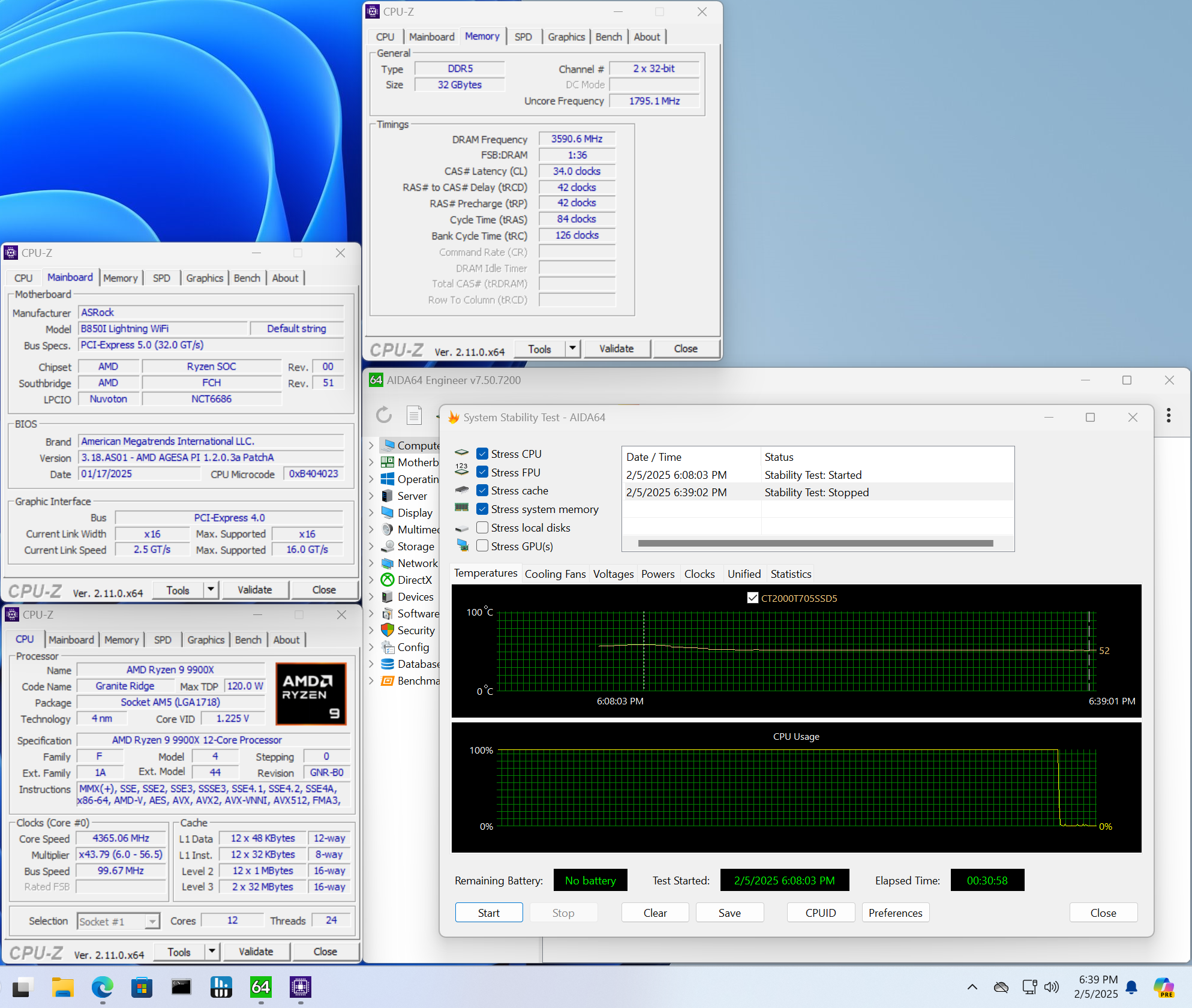
As you may have read earlier, we could run all kits except the DDR5-8000 without issue. If you follow the memory QVL list (we didn’t), you’ll have a better chance of reaching these higher speeds.
Power Consumption / VRM Temperatures
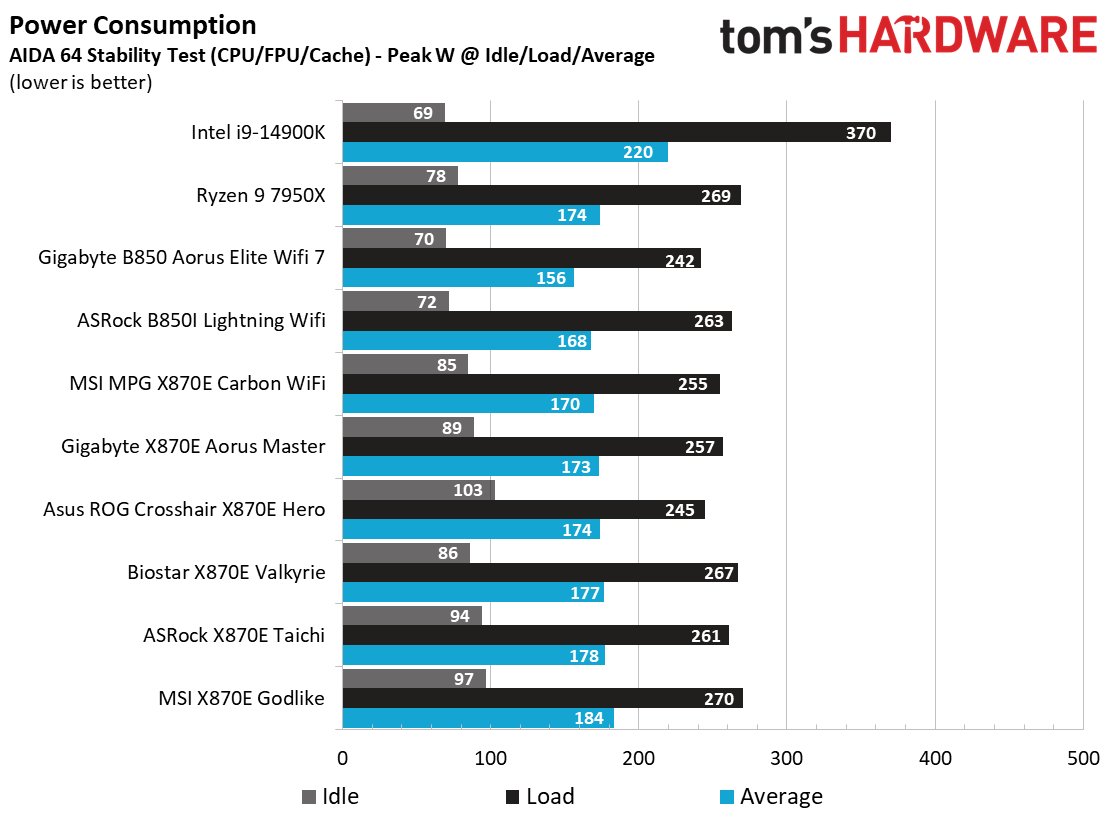
We used AIDA64’s System Stability Test with Stress CPU, FPU, Cache, and Memory enabled for power testing, using the processor's peak power consumption value. The wattage reading is from the wall via a Kill-A-Watt meter to capture the entire PC (minus the monitor). The only variable that changes is the motherboard; all other parts remain the same. Please note that we moved to using only the stock power use/VRM temperature charts, as this section aims to ensure the power delivery can handle flagship-class processors.
The Ryzen 9 9990X's power consumption is tame compared to the 7950X we used for X670/X670E. Where, in the past, high-end boards would peak at nearly 300W, the systems now top out at 250-270W during the CPU stress tests (gaming with the Nvidia RTX 4080 is another story). The B850I Lightning peaked at 263W and idled at 72W, one of the lower idle values. So long as you can keep adequate ventilation in your chassis, this board will support anything you can throw at it.

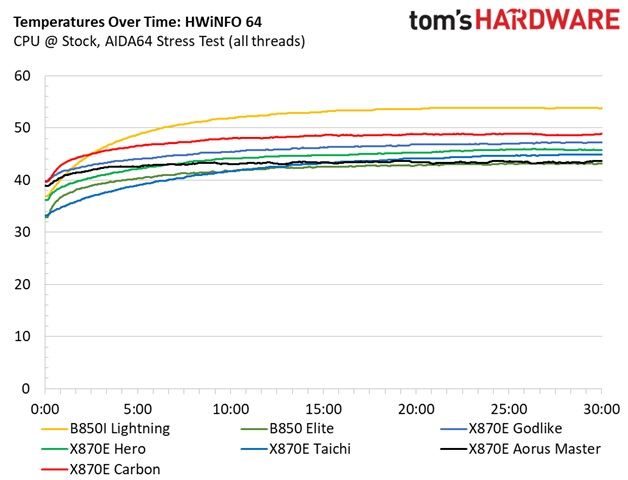
VRM temperatures peaked around 54 degrees Celsius in our testing. But mind you, that’s on an open-air test bench. Although they’ll run warmer in a case, there’s still plenty of headroom left.
Bottom Line
ASRock’s B850I Lightning is an excellent value in the Mini-ITX space. For just over $200, you get full support for AM5-based processors, including the higher-powered flagship-class options. You get capable power delivery, integrated Wi-Fi 6E, PCIe 5.0-capable M.2 and GPU slot, a solid audio solution, outstanding performance, and a generally neutral design sporting a black PCB and the Phantom Gaming purple and highlights, fitting most build themes. Performance was also good out of the box. Quite frankly, there’s not much to complain about here, especially when considering the price.
Regarding the competition, Asus’ B850-I Gaming offers Wi-Fi 7, faster USB (20 Gbps port), and a better audio codec, but it costs almost $100 more. Gigabyte’s B850I Aorus Pro has similar specifications as the Asus and can be found for $259.99), while MSI doesn’t have any skin in the B850 Mini-ITX game (they’re all ATX boards).
All options their pros and cons, but it will come down to budget and whether you need to spend the additional $50-90 on faster Wi-Fi and USB ports and a better (on paper) audio solution. If you don’t need those features, buying ASRock’s B850I Lighting for your modern, small-form-factor needs is a no-brainer.
MORE: Best Motherboards
MORE: How To Choose A Motherboard
MORE: All Motherboard Content

Joe Shields is a staff writer at Tom’s Hardware. He reviews motherboards and PC components.
-
lmcnabney Your purchase links go to the A620I.Reply
Also, if it was mATX it would be a $140 board. That's a 50% premium for a small board that still only has 7 layers. -
logainofhades None of those cons are cons to me, really. If I were to rebuild in one of my ITX cases, this would be on my list of boards to consider.Reply -
HideOut While it sucks to have an older audio codec, the 1220 isnt horrible. Its far better than the 8xx crap some boards come with.Reply -
Notton IMO, in some ways, socket 754 was way ahead of it's time.Reply
AM5 mobos need to work with a 16-core, potentially even a 24 to 32-core down the line, and the VRMs are complete overkill for an 6 or 8-core.
Extra VRMs aren't free and neither is the space they occupy on an already cramped board.
Minisforum's BD795i / BD795M approach to this is better from a budget and I'm never going to upgrade the CPU or mobo perspective. All it really needs to be perfect is a mobile 8-core X3D chip with an iGPU and faster DDR5.
Instead, we get these so-called "budget" mITX mobos that have outlived their usefulness. -
Mopar_63 I think sometimes, with a gaming ITX board, to much emphasis is put in the wrong places.Reply
The B850I looks to be a great gaming board and at current prices easily the best option. Losing Wifi7 might matter if you spend all your time with large data transfers but for day to day use and gaming Wifi6 does a wonderful job. I see at the other end of my house connections speeds to 600mb and latency of around 20ms for internet connectivity which is more than enough for a great gaming, or everyday use experience. Adding Wifi 7 might add more bandwidth but except for downloading the games it does not really matter.
For audio, the AC1220 might not be the most current but it is a SOLID choice. If you need better audio, you're always better off going with a USB AMP/DAC instead of a newer motherboard codec.
Lack of USB 4? Again, who cares, the only time the high-speed USB comes into play is if you're using an external storage device. Even with a simple USB C I can max out an external SSD, no need for USB 4 yet. Speaking of that this board takes dings for having 4 USB 2.0 connections. However again, as a gamer this will not harm you. Keyboard, Mouse, AMP/DAC and Camera all work fine on USB 2.0 gaining nothing from the higher speed connections.
I do hate that we think of a $200 board as a budget option but if you're building a SFF Gaming rig this board is the best choice on the market of current generation boards. -
ocer9999 Reply
I think at this point is just the new normal and I dont even think companies are making much money, it's the cost of things gone up so much the last 4 years..qwertymac93 said:It blows my mind that over $200 is considered "budget" now.
But I agree I don't think USB 4.0 is relevant for the foreseeable future, I wouldn't say the B850i is a no go because of that.. -
2Be_or_Not2Be ASRock's Phantom Gaming mITX boards were usually ones that had the latest technology parts integrated onto the small mITX format, at a slightly cheaper price versus ones from MSI/Asus. It's why I usually purchased their boards. So now they've put the PG branding on this board, but without the associated latest-tech components (USB4, WiFi7, etc.). That, to me, is a bit of letdown for this series. So while I usually considered all of the latest from each board maker, now they lose a bit in comparison.Reply
Perhaps they'll release a "fully-loaded" mITX board with the PG moniker & the 870 chipset.
